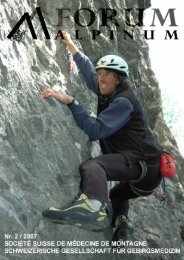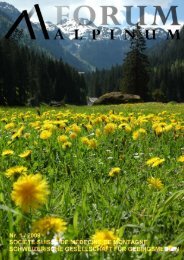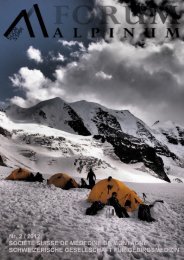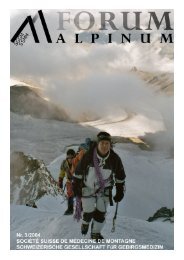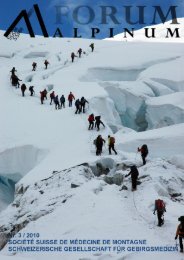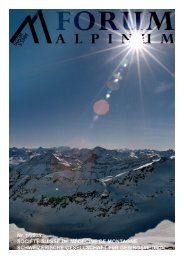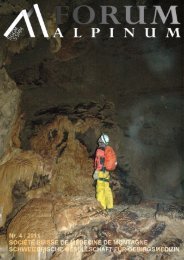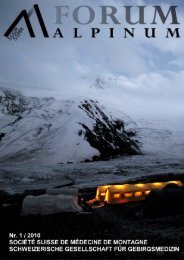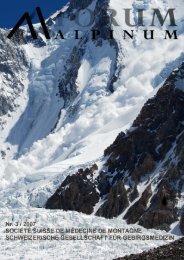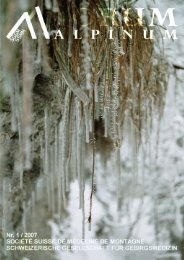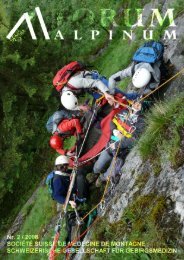abstracts 2010 - Schweizerische Gesellschaft für Gebirgsmedizin
abstracts 2010 - Schweizerische Gesellschaft für Gebirgsmedizin
abstracts 2010 - Schweizerische Gesellschaft für Gebirgsmedizin
Sie wollen auch ein ePaper? Erhöhen Sie die Reichweite Ihrer Titel.
YUMPU macht aus Druck-PDFs automatisch weboptimierte ePaper, die Google liebt.
Start CPR:<br />
As soon as it can<br />
be continued<br />
without delay!<br />
Exceptions!!<br />
3. On-Site treatment of HT IV<br />
Durrer B., Brugger H.et al. Advanced changes in Resuscitation Hypothermia. Resuscitation. 2001; 50:243-246<br />
3. On-Site treatment of HT III<br />
INTUBATION ?<br />
Protective reflexes ?<br />
Yes:<br />
Intubate only if quick iv line !<br />
Lateral position, monitoring,<br />
No: Intubation<br />
Load and go or stay and play ?<br />
Durrer B., Brugger H.et al. Advanced changes in Resuscitation Hypothermia. Resuscitation. 2001; 50:243-246<br />
Potential Triggers for<br />
Ventricular Fibrillation:<br />
- Hypoxia<br />
- Rough g Handlingg<br />
- Suction<br />
- Intubation<br />
- Esophageal sonde<br />
Risk: < 33/ 32 o<br />
Risk ↑: < 28 o<br />
4. Post rescue collaps<br />
HT II + III<br />
M 8<br />
M 7<br />
Prevention:<br />
Good Pre-oxygenation !<br />
Grueskin J et al,A pilot study of mechanical stimulation and cardiac dysrhythmias in porcin model,<br />
Wilderness and Environ Med., Sumer 2007; 18(2):133-7<br />
3. On-Site treatment of HT III<br />
• Careful handling to avoid<br />
ventricular fibrillation<br />
• Monitoring<br />
• Treat additional injuries<br />
• Hospital: with CPB / FASR / CWD ?<br />
Durrer B., Brugger H.et al. Advanced changes in Resuscitation Hypothermia. Resuscitation. 2001; 50:243-246<br />
4. Post rescue collaps<br />
HT II + III<br />
HT II / III + uncareful handling:<br />
Afterdrop ↑ → Coretemperature<br />
Coretemperature↓ ↓<br />
Irritable myocardium<br />
triggers ventricular fibrillation<br />
Not much data - but many case reports ! 0,8% aller HT?<br />
B rooks CJ. et al. How much did cold shock … Occup Med (Lond) Sep 2005; 55(6) :459-62<br />
American Heart Association. American Heart Association Guidelines for Cardiopulmonary Resuscitation and Emergency<br />
Cardiovascular Care. Circulation 2005;112:IV-136-IV-138<br />
5. Prevention of further cooling out<br />
Improvised<br />
• Wind-chill protection<br />
• Isolation layers, ground<br />
• Changing wet cloths<br />
• Hot sugared drinks drinks, food<br />
(HT I+II) !!!!<br />
• Body body rewarming<br />
Be After aware the excavation !! or after the rescue<br />
out of a crevasse the victim can cool out<br />
twice as fast! Wind and wet cloths!<br />
Giesbrecht GG et al. Treatment of mild immersion hypothermia by direct body-to-body contact.<br />
J Appl Physiol Jun 1994; 76(6) :2373-9<br />
M 9<br />
4



